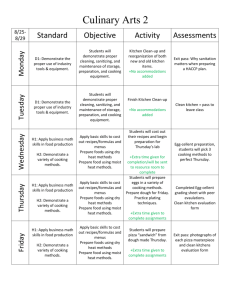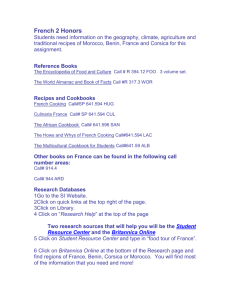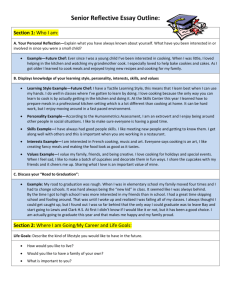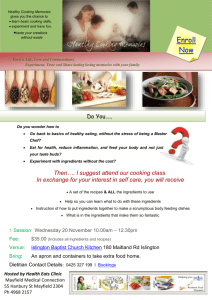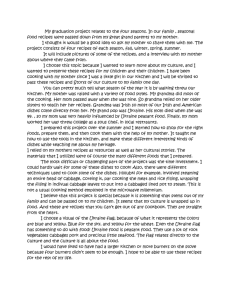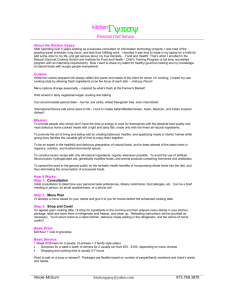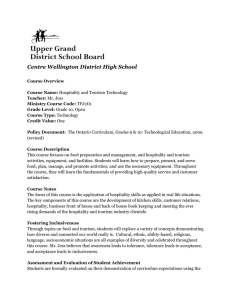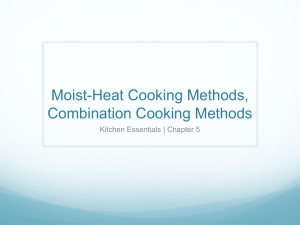Booklist Food Webinar Slide 1—if you`re still with me, then you`re
advertisement
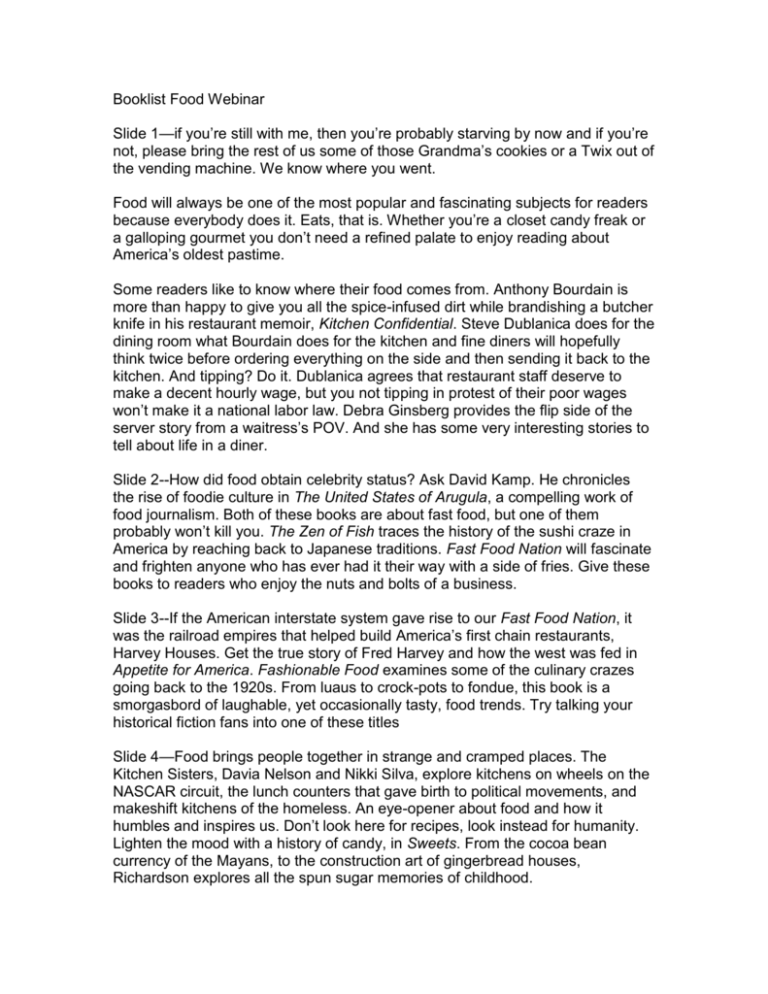
Booklist Food Webinar Slide 1—if you’re still with me, then you’re probably starving by now and if you’re not, please bring the rest of us some of those Grandma’s cookies or a Twix out of the vending machine. We know where you went. Food will always be one of the most popular and fascinating subjects for readers because everybody does it. Eats, that is. Whether you’re a closet candy freak or a galloping gourmet you don’t need a refined palate to enjoy reading about America’s oldest pastime. Some readers like to know where their food comes from. Anthony Bourdain is more than happy to give you all the spice-infused dirt while brandishing a butcher knife in his restaurant memoir, Kitchen Confidential. Steve Dublanica does for the dining room what Bourdain does for the kitchen and fine diners will hopefully think twice before ordering everything on the side and then sending it back to the kitchen. And tipping? Do it. Dublanica agrees that restaurant staff deserve to make a decent hourly wage, but you not tipping in protest of their poor wages won’t make it a national labor law. Debra Ginsberg provides the flip side of the server story from a waitress’s POV. And she has some very interesting stories to tell about life in a diner. Slide 2--How did food obtain celebrity status? Ask David Kamp. He chronicles the rise of foodie culture in The United States of Arugula, a compelling work of food journalism. Both of these books are about fast food, but one of them probably won’t kill you. The Zen of Fish traces the history of the sushi craze in America by reaching back to Japanese traditions. Fast Food Nation will fascinate and frighten anyone who has ever had it their way with a side of fries. Give these books to readers who enjoy the nuts and bolts of a business. Slide 3--If the American interstate system gave rise to our Fast Food Nation, it was the railroad empires that helped build America’s first chain restaurants, Harvey Houses. Get the true story of Fred Harvey and how the west was fed in Appetite for America. Fashionable Food examines some of the culinary crazes going back to the 1920s. From luaus to crock-pots to fondue, this book is a smorgasbord of laughable, yet occasionally tasty, food trends. Try talking your historical fiction fans into one of these titles Slide 4—Food brings people together in strange and cramped places. The Kitchen Sisters, Davia Nelson and Nikki Silva, explore kitchens on wheels on the NASCAR circuit, the lunch counters that gave birth to political movements, and makeshift kitchens of the homeless. An eye-opener about food and how it humbles and inspires us. Don’t look here for recipes, look instead for humanity. Lighten the mood with a history of candy, in Sweets. From the cocoa bean currency of the Mayans, to the construction art of gingerbread houses, Richardson explores all the spun sugar memories of childhood. Slide 5—Remember when I said if you were still with me you were probably starving? Yeah, well, let’s cure that with Horsemen of the Esophagus. Americans will compete for anything, even a golden hot dog trophy. Fast food gets a whole new meaning here. Each winner deserves a year’s supply of Pepto Bismol. Anytime someone throws a potluck, at least two women go into Olympic-level competition mode. Think dueling-cupcake-mommies raised to the highest stake in Cookoff: Recipe Fever in America. There are thousands of cooking contests held every year from chili cook offs to that Holy Measuring Cup of contests, the Pillsbury Bake-Off contest. These ladies could shrivel all the knives of the Iron Chef. Slide 6—Cooking is a science. The unexamined pot roast is not worth eating. Russ Parsons takes some basic cooking tenets and applies accessible science t explain why onions make us cry, how apples get “mealy” and why potatoes are better boiled than fried. Oh, and there’s some recipes in here, too, to prove his point, that cooking is matter of carefully crafted formulas. Cake Wrecks is the schadenfreude of dessert picture books. We all know we’ll never bake like Martha, but we can misspell names, accidentally make a baseball look like a wayward body part, and whip up black frosting that would scare Wes Craven. No one’s caught it on camera—yet. Find the funny in the bakery flipping through these butter cream monstrosities. Slide 7—Everybody likes to talk about food and apparently write about it. Food memoirs are one of the most popular subgenres of memoir. Barbara Kingsolver applies her thoughtful, humorous writing style to a year of eating locally and off her own land Animal Vegetable Miracle. She’s not preachy about it either. Patricia Volk focuses on the recipe that makes a quirky, loving family and what feeds them. As much about food as it is her delightful relatives, Volk’s story is funny, touching, and nostalgic. Good for book groups. Give A Stew or a Story to the fierce foodies who also read. MFK Fisher’s eclectic mix of essays on people and places, as well as food, is not just about the ingredients, it’s about the love of a profession. Slide 8—What a great pairing we have here! Ann’s tropical island cooking adventures with oregano-eating goats and nutmeg plantations and Jason’s rapid fire, “I get paid to play with knives” in New York’s culinary madhouses. Both talk about food and the people who cook it with passion in completely different ways. Give Spice Necklace to fans of the Barefoot Contessa and give Cooking Dirty to readers who want to be Cake Boss. Slide 9—If he’s master of the grill and she’s mistress of the sauté pan, they’ll both see the humor and wisdom in He said Beer, She said Wine. They make informed inspired suggestions for pairing beer and wine with everything from pizza to petit fours. Of course women eat. Our emotional relationship with food is so complex sometimes even we don’t understand it. The essay collection in Women Who Eat explores many of our conflicted feelings and offers some recipes for garnish. Slide 10—Guys probably aren’t as conflicted, as evidenced by the Two Dudes in their first cookbook. While women are scouring the pantry for all suitable ingredients, the dudes are checking the cupboards to see if there’s a cooking vessel he can both cook in and eat from. But don’t write these guys off, they offer 100 one-pan recipes that use minimal ingredients and prep time hearkening back to their early days of no money, ingredients, or cookware. And of course, what kind of cookbook presentation would this be without the Kitchen Goddess herself, Julia Child? Slide 11-- Everyone walks into the kitchen sometime, even if it’s just leave the dirty dishes or gaze into the fridge one more time. Which is why these books are here. They are picture books of food for adults. What I think of as food porn. These foodstuffs are dressed up, garnished, butter-dabbed, and make you want to lick the page. Slide 12—The Blackberry Farm Cookbook takes this fantasy further. It’s a fantasy picture book about how grownups would live and eat if they ran away to Blackberry Farm and money and waistlines were no object. See? Adults still read fairy tales, we call them cookbooks.
